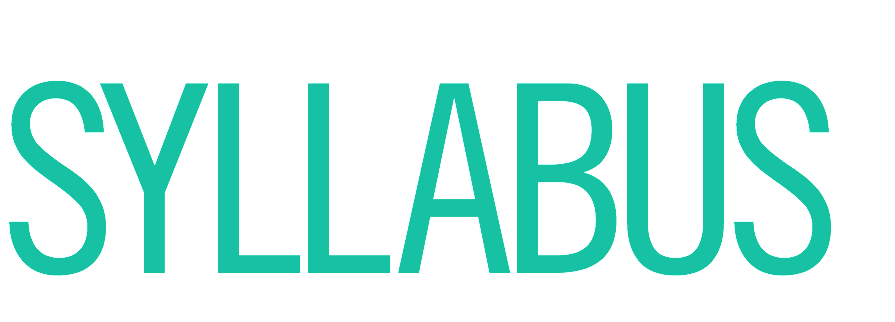

ART 302 | VIDEO/DIGITAL ART | FALL 2017
OFFICE HOURS:
Tuesday & Thursday, 4:45-5:30pm or by email in Sagebrush Hall.
OVERVIEW:
Prerequisite: ART 200.
Studies into artistic concepts and technologies involved in the creation of video art, and digital time-based art forms. Investigations into digital imaging, non-linear compositing and visual effects result in the creation of short artistic statements presented in video/digital format. 6 hours lab.
Expanded description: This course is designed to serve animators, graphic designers, image makers, artists and others seeking an overview of digital motion art approaches and technologies with an emphasis on post-production techniques. Especially useful for students interested in motion graphics. You should have access to a video camera (any type is OK, DV is best).
SOFTWARE:
After Effects, Final Cut Pro, Motion, Cinema 4D, Photoshop, Illustrator, etc.
ART DEPARTMENT PROGRAM GOALS IMPLEMENTED IN ART 302:
• Basic Skills: Develop a foundation of art knowledge, theories, skills, craftspersonship, and technologies, through which ideas and concepts are communicated in writing, speaking, and art making.
• Art Knowledge : Broaden knowledge of art and develop an understanding of art within theoretical, cultural, and historical contexts.
• Critical Thinking: Analyze, interpret, and question traditional methodologies and pre-conceived notions of art and art making through the process of generating and solving problems.
ART DEPARTMENT STUDENT LEARNING OUTCOMES IN ART 302:
• Students will acquire competent knowledge and skills in various art media, concepts and methodologies. Understand and apply the elements and principles of design as they relate to photography’s ability to impose a frame upon the three- dimensional world and translate it into two dimensions.
• Acquire basic photography skills: camera anatomy and functions, the relationship among fstop, shutter speed, and ISO, correct exposure and white balance
• Students will solve visual problems at a competent level, including understanding/application of the elements of art and principles of design.
• Acquire visual literacy through viewing, discussing and evaluating the work of both historical and contemporary videographers.
• Students will acquire historical and contemporary knowledge of diverse cultural and aesthetic contexts, including political, visual and material culture.
• Analyze videos, both verbally and written, through critique and self-reflection.
• Approach image making from a conceptual perspective by using the camera’s frame and video software to create and manipulate content.
ASSIGNMENTS:
There will be 12 projects throughout the semester. Students will generally have time to work on them during each class period, but they will often require time outside of class to complete properly. More complex projects will be given more time.
All projects will be uploaded to myCSUNbox on the date due, the original files will be kept until the end of the semester. In
ATTENDANCE:
Students are expected to attend all class meetings. If you do not attend the first two class meetings, the attendance policy states you have lost the right to attend this class unless you have notified the instructor that the absence is temporary. Failure to withdraw will result in the instructor assigning you a grade of “U” which, in computing a student’s grade point average, counts as an “F”.
Attendance is required and is a strong determinate to the students’ success in the course. Each 3 non-excused absences will result in a lowered final grade by a full grade. Students arriving more than 30 minutes late will be marked absent. 2 Tardies will count as 1 absent.
Students will be held responsible for any information and deadlines given in class regardless of whether or not the student is in class.
Lectures, demos and handouts are not repeated for absences, lates, or early leaves. If absent, late or early leave, get lecture and demo notes from students in the class. Do not ask the instructor for a recap of materials covered in class during your absence.
GRADING:
Project grades will be issued on a numerical scale, based on the following criteria: Strength of concept (originality)
Use of principals taught in class
Aesthetics
Each criteria is evaluated based on a point system:
10 Excellent
8 Good
6 Average
4 Weak
2 Poor
0 Not Shown
Each project will have 30 possible points.
The final grade will be calculated using the following distribution:
60% weekly projects, 25% final project, 15% participation.
Final course grades are issued based on a straight percentage, broken down as follows:
100-93 A
92-90 A-
89-87 B+
86-83 B
82-80 B-
79-77 C+
76-73 C
72-70 C-
69-67 D+
66-63 D
62-60 D-
59-00 F
LATE WORK:
Late project grades will be accepted for 1 week past the due date, but will be reduced by one grade per class meeting. The final project is mandatory and cannot be turned in late.
SUGGESTED/OPTIONAL TEXTS:
Visual Quickstart Guide: AfterEffects
SUPPLIES:
USB flash drive for work in progress (at least 16GB), or an external harddrive.
EMAIL:
Your CSUN email account is considered an o cial means of contacting you. If you regularly use another account, please forward your CSUN mail to your preferred account. Login to www.csun.edu/webmail and select “Options,” then “Forwarding.” Input your preferred email address and click “Start.”

